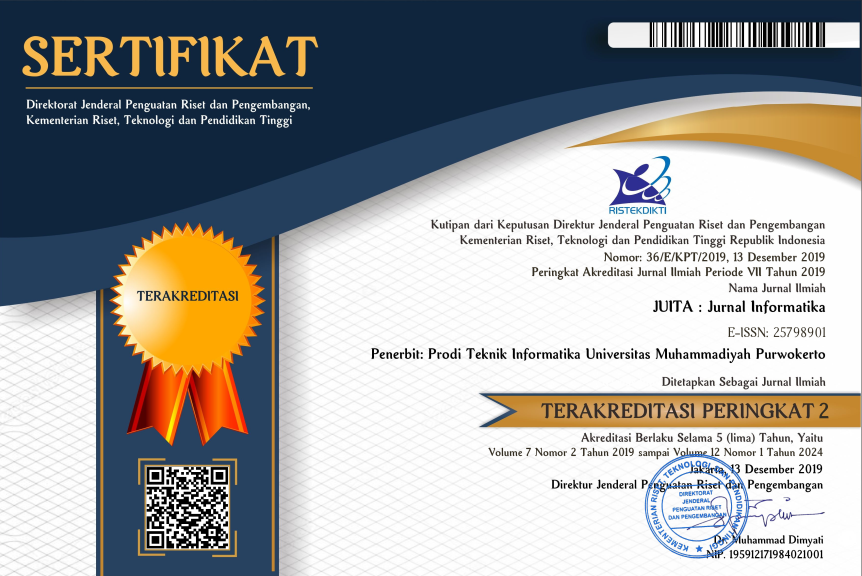Monitoring the Performance of Lecturers Using Behaviorally Anchor Rating Scale and Management by Objectives Method
DOI:
https://doi.org/10.30595/juita.v11i1.15354Keywords:
Evaluation, Data Monitoring, Performance, Management By ObjectivesAbstract
Mutiara Mahakam Samarinda Institute of Health Sciences (STIKES-MM Samarinda) has a system for monitoring and evaluating the performance of lecturers or education staff. This system measures performance achievements in terms of teaching, research, and community service. . Nevertheless, since every segment of the system is not yet fully computerized, this then raises several obstacles in the process of monitoring and evaluating the performance, length of time to obtain the final assessment results and the low accuracy level of the assessment. This study aims to seeks solutions to these obstacles and offers an educator performance monitoring system that combines the Behaviorally Anchor Rating Scale (BARS) and Management by Objectives (MBO) methods to be assessed quantitatively based on the rating scores in measuring the two methods. The BARS method was focused on evaluating behaviour that would affect overall performance with an average score of 4.14%, while the MBO method was focused on evaluating according to Tri Dharma of higher education, namely teaching, research and community service. The assessment system was then implemented to evaluate the performance of lecturers and education staff. Subsequently, the data obtained were analyzed to get the final result of the assessment. In particular for data from the MBO method, the analysis was carried out using step with and without KRA. This exploratory research succeeded in presenting the final results of the performance assessment of each lecturer who was assessed for both the value of the BARS and MBO methods. Data analysis from the MBO method , when calculated with and without KRA and KRA, showed some significant differences in MBO. For all lecturers, the difference in scores, if the average was 3.48%, then this assessment was more inclined to the BARS assessment, which had a better rating than MBO.
References
[1] I. A. Permana, “Analisis Penilaian Kinerja Dosen Menggunakan Metode Balance Scorecard (Studi Kasus Stt Sangkakala),” J. Ris. Ekon. dan Bisnis, vol. 13, no. 2, pp. 89–99, 2020, doi: 10.26623/jreb.v13i2.2437.
[2] S. Sandiwarno, “Developing an E-Forum to Universitas Mercu Buana Alumni ’ s to Improve Effective Communication and Educative by Technology Multimedia Acceptance Model,” Int. J. Comput. Sci. Mob. Comput., vol. 7, no. 8, pp. 113–122, 2018.
[3] A. Yudhana, A. Fadlil, and L. Prianto, Eko Teori, “Kepegawaian Dan Kegiatan Berbasis Android,” Pros. Semin. Nas. MULTI DISIPLIN ILMU CALL PAPAERS UNISBANK KE-3(SENDI _U 3) 2017, vol. 3, no. ISBN-9-789-7936-499-93, pp. 63–68, 2017.
[4] M. Guntur and R. Yanto, “Penerapan Metode SMART untuk Seleksi Kelayakan Penerima Bantuan Pengembangan Usaha Pangan Masyarakat,” Telematika, vol. 12, no. 2, pp. 149–159, 2019.
[5] M. F. Hasa, A. Yudhana, and A. Fadlil, “Analisis Tata Kelola Sitem Informasi Akademik Universitas Muhammadiyah Sorong,” J. Tek. Unkris, vol. 1, pp. 529–535, 2019.
[6] A. Rohman and P. Mauliana, “Aplikasi Diagnosis Penyakit Ibu Hamil Menggunakan Certainty Faktor Berbasis Android,” E-Prosiding Tek. Inform., vol. 3, no. 1, 2022.
[7] A. Yudhana, A. Fadlil, and M. Rosidin, “Indonesian words error detection system using nazief adriani stemmer algorithm,” Int. J. Adv. Comput. Sci. Appl., vol. 10, no. 12, pp. 219–225, 2019, doi: 10.14569/ijacsa.2019.0101231.
[8] R. Umar, A. Yudhana, and M. N. Faiz, “Experimental analysis of web browser sessions using live forensics method,” Int. J. Electr. Comput. Eng., vol. 8, no. 5, pp. 2951–2958, 2018, doi: 10.11591/ijece.v8i5.pp.2951-2958.
[9] F. Alameka, “Sistem Manajemen Data Monografi Di Kelurahan Sidodadi,” Ilk. J. Ilm., vol. 8, no. 3, pp. 167–173, 2016, doi: 10.33096/ilkom.v8i3.67.167-173.
[10] S. Hidayatulloh, N. R. Hidayati, S. Nita, and K. Pos, “Rancang Bangun Sistem Informasi Pick Up Kiriman Pos Berbasis Web,” Semin. Nas. Teknol. Inf. dan Komun. Literasi Digit. pada Era Revolusi Ind. 4.0 Senat., pp. 366–373, 2018.
[11] H. E. Saputra, “Membangun Web Engineering Puzzle Research Data Mining Menggunakan Model Navigational Development Technique,” J. Rekayasa dan Manaj. Sist. Inf., vol. 2, no. 1, pp. 1–10, 2016.
[12] D. A. Pramudita and R. Christy, “Sistem Pendukung Keputusan Untuk Penilaian Rumah Sakit Terbaik Di Lampung Tengah Menggunakan Metode Ahp,” J. Data Min. dan Sist. Inf., vol. 1, no. 1, p. 10, 2020, doi: 10.33365/jdmsi.v1i1.800.
[13] F. M. Ayudewi, A. Yudhana, and R. Umar, “Monitoring Pertumbuhan Kecambah Kacang Hijau Menggunakan Region Growing,” J. Repos., vol. 2, no. 9, pp. 1–9, 2020, doi: 10.22219/repositor.v2i9.992.
[14] Evayani and U. Utamy, “Perancangan Database Sistem Informasi Akuntansi Siklus Penjualan Dengan Menggunakan Model REA (Studi Kasus pada PT Yudi Putra, Medan),” J. Ilm. Mhs. Ekon. Akunt., vol. 1, no. 2, pp. 16–29, 2016.
[15] A. A. Mahmudi, “Sistem informasi penilaian kinerja dosen dan karyawan berbasis web,” Surya Inform., vol. 1, no. 1, pp. 55–60, 2015.
[16] M. S. Dzakwan, S. S. Sunardi, and A. Yudhana, “Monitoring Data Pendidik Menggunakan Metode Web Engineering,” Cybernetics, vol. 4, no. 01, p. 19, 2020, doi: 10.29406/cbn.v4i01.2096.
[17] C. Triwibisono, F. N. Nugraha, P. Studi, T. Industri, F. R. Industri, and U. Telkom, “Perancangan Penilaian Kinerja Karyawan Menggunakan Metode Behaviorally Anchored Rating Scales ( Bars ) Di Pt Widya Trans Cargo Designing Performance Appraisal Using the Behaviorally,” e-Proceeding Eng. Vol.8, vol. 8, pp. 2253–2261, 2021.
[18] Y. Dharma Putra, I. N. S. Kumara, N. W. S. Ariyani, and I. B. A. Swamardika, “Literature Review Analisis Kinerja SDM Menggunakan Metode Behaviorally Anchored Rating Scale (BARS),” Maj. Ilm. Teknol. Elektro, vol. 20, no. 1, p. 103, 2021, doi: 10.24843/mite.2021.v20i01.p12.
[19] A. L. Harahap and S. Perdana, “Analisis Penilaian Kinerja Karyawan Menggunakan Metode Behaviorally Anchor Rating Scale ( BARS ) Dan Management By Objctives ( MBO ) Di CV BRILLIANT,” J. IKRAITH-HUMANIORA, vol. 5, no. 3, pp. 18–26, 2019.
[20] S. N. Evita, W. O. Z. Muizu, and Raden Tri Wayu Atmojo, “Penilaian Kinerja Karyawan Dengan Menggunakan Metode Behaviorally Anchor Rating Scale dan Management By Objectives (Studi kasus pada PT Qwords Company International),” Pekbis J., vol. 9, no. 1, pp. 18–32, 2017.
Downloads
Published
How to Cite
Issue
Section
License

JUITA: Jurnal Informatika is licensed under a Creative Commons Attribution 4.0 International License.
















